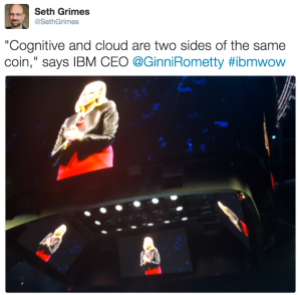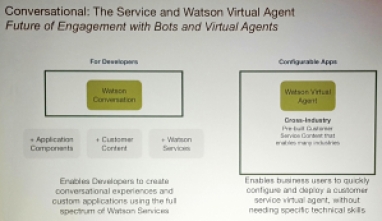If you’re into enterprise, cloud computing — and data, analytics, machine learning, and conversational interfaces — this article is for you. It’s my report from the 2016 World of Watson conference, written for both those who missed the event and those who attended. IBM stated 17,000 Las Vegas attendance and there was a lot to absorb!
At World of Watson, I saw computing’s future… and also technologies that I associate with a pre-cognitive past. (Disclosure: IBM paid my conference fees and hotel room.) I encountered a tech giant with vision, amazing alliances, and unique computing assets… and I saw lingering limitations I wouldn’t have expected.
I’ll open this report with three key IBM messaging points, followed by three observations about products and positioning. I’ll close with four points where, in my view, IBM hasn’t yet hit the mark. Total:
Ten Take-Aways from IBM’s World of Watson
 “Cognitive and cloud are two sides of the same coin.” So said IBM CEO Ginni Rometty in her World of Watson (WOW) keynote. Actually, that’s not new material. It’s more fully articulated in 2015 Annual Report chairman’s letter:
“Cognitive and cloud are two sides of the same coin.” So said IBM CEO Ginni Rometty in her World of Watson (WOW) keynote. Actually, that’s not new material. It’s more fully articulated in 2015 Annual Report chairman’s letter:
Cognitive and cloud — many in our industry see these as two separate phenomena. We see them differently: as two sides of the same coin, two dimensions of a single model. Cognitive is the only way to ingest and extract value from the new natural resource of data in all its forms, so that it can be turned into competitive advantage and societal value. And cloud is the platform on which these solutions are designed, built, tested and deployed in the world.
- IBM aims for “embodied cognition.” That’s cognition that will be embedded in devices, vehicles, robots, and what-have-you, responding situationally in accordance with the type and purpose of the embodiment. I don’t have a WOW citation for you. Instead I’ll quote IBM Chief Scientist for Software Engineering Grady Booch. In a 2015 panel, Booch speaks of “the touchpoint of human and big data interaction that’s then mediated by a cognitive system”:
Imagine then, a system that is in the world, that has models of the world, and interacts with the world, and yet, has the intelligence and common sense of an AI. That space and intersection is quite interesting. It’s what I call ‘the socially intelligent and cooperative robot.’
- For IBM, AI is not artificial intelligence, it’s augmented intelligence. This spin captures the idea that AI is assistive to humans (and vice versa?) and relies on cognitive’s promise of natural human-machine interfaces. Augmented versus artificial represents “the critical difference between systems that enhance and scale human expertise rather than those that attempt to replicate all of human intelligence.”
- Legacy has legs. While there’s nothing cognitive about DB2, IBM’s flagship database system, first released in 1983, the platform is still selling and still evolving. I had a couple of conversations about DB2 at World of Watson even though the product wasn’t showcased there. DB2 is now cloud-deployable and capable of handling mixed transactional and analytical workloads. Unlike DB2, IBM Watson Content Analytics was featured at WOW, similarly legacy technology despite the newish addition of “Watson” to the product name. IWCA (let’s call it) relies on lexicons, manual annotations, and language rules — language engineering, via IBM Watson Knowledge Studio (again newly “Watson”-branded) — old-school approaches in a world tending toward ubiquitous machine learning.
- Spark over Hadoop, at least for the newly launched IBM Data Platform, which provides “cognitive assistance for creating machine learning models,” according to IBM PR. “Built on Apache Spark, Watson Machine Learning intelligently and automatically builds models from structured and unstructured data and open machine learning libraries, while accelerating model deployment into business operations.” For further analysis, read Tony Baer’s WOW report, Have we reached Peak Hadoop?
- IBM is in a class by itself… or at least thinks it is. I recollect no significant WOW mention of the competition — not Amazon, Google, Microsoft, Oracle, SAP, or Salesforce. I suppose a key difference is that unlike enterprise-market rivals, IBM remains a technology provider rather than a solutions company. Watson is a collection of technologies, presented as a platform and toolkit. Solutions are delivered via partnerships, and in fact, some of the competitors I named were present at WOW as IBM partners. Whether the market rewards or punishes IBM for this positioning remains to be seen.
- Is IBM a data company? Undecided. Last year’s IBM acquisition of the Weather Company was an interesting move. As I wrote recently in Lessons from IBM’s Chief Data Officer, while five years ago “Marc Andreessen famously declared ‘software is eating the world,’ today, with the ascendance of machine learning, social, and the Internet of Things — each a Watson element and each an IBM CDO concern — data is eating software.” Weather Company data did get A LOT of play at WOW, yet IBM has made no other, similar acquisitions. Isn’t more data better? Financial, corporate, and consumer information and annotated social feeds would neatly complement that first big data acquisition. But I guess IBM, at least, can eat just one.
- The IBM Marketplace isn’t a marketplace. It’s just a store. Definitions of “marketplace” typically include words such as “open” and “compete.” IBM’s marketplace isn’t open, and it doesn’t foster competition. Contrast with Salesforce AppExchange, a platform for (just about) anyone to buy and sell Salesforce-platform apps, components, and consulting.
- IBM’s cognitive dress isn’t actually cognitive. Nor really is the self-driving vehicle, Olli. Diodes in the Marchesa dress, which was on display in WOW’s Cognitive Concourse exhibit area, change color based on Watson sentiment analysis of certain hashtagged tweets. Twitter sentiment analysis is old hat; you can find two dozen different Web services that support the capability in one fashion or another. Cognitive: To me that would be a dress that responded to the wearer’s mood, detected via biosensors, and to the wearer’s surroundings. This supposed cognitive dress was, instead, simply a display device for sentiment mined via cognitive services. Now consider minibus Olli, created by Local Motors. You can converse with Olli: Cool! Watson powers the conversation, however it doesn’t drive Olli. You could get a similar conversational capability, it seems to me, if you duct-taped an iPhone with a Watson interface to Olli’s ceiling. Watson analytics are predictive and even prescriptive, but they’re not yet in control.
- I was surprised by the limited use of machine learning in foundational projects, in Watson Conversation and Watson Virtual Agent, the first a technology for developers and the second a configurable app for business users.
 To illustrate the limitations, I’ll deep-link you into Conversation Service documentation. Steps such as defining intents and entities and building a dialog constitute “feature engineering,” the application of human domain expertise to craft a customer-service interaction. That sort of approach is necessary when you don’t have dialog data to work from. It’s akin to the “language engineering” that I described in point 4, above. My complaint is the absence of any machine-learning alternative, any possibility of automatically associating entities and intents with responses by mining search, customer-service dialog, and social-interaction data and the like. The data’s out there, so why can’t I use it? The creation of Watson conversations and virtual agent is not cognitive.
To illustrate the limitations, I’ll deep-link you into Conversation Service documentation. Steps such as defining intents and entities and building a dialog constitute “feature engineering,” the application of human domain expertise to craft a customer-service interaction. That sort of approach is necessary when you don’t have dialog data to work from. It’s akin to the “language engineering” that I described in point 4, above. My complaint is the absence of any machine-learning alternative, any possibility of automatically associating entities and intents with responses by mining search, customer-service dialog, and social-interaction data and the like. The data’s out there, so why can’t I use it? The creation of Watson conversations and virtual agent is not cognitive.
Watson is the product of immense vision and talent, positioned to transform business, education, medicine, transportation, and most every other computable aspect of everyday life. Practicality is a drag, however: the imperative that IBM support legacy businesses and the reality that even IBM-scale resources aren’t sufficient to deliver pure-cognitive systems from day one, or even from day one thousand. It will take time to realize the vision, and my 2016 World of Watson visit shows that IBM is well on the way.
Fans of cognitive computing — of NLP, text & speech analytics, sentiment analysis, and conversational interfaces — join me at the LT-Accelerate, a unique European event for applications that include market research, consumer insights, media analysis, and finance. LT-Accelerate takes place November 21-22, 2016 in Brussels. See you there?
Seth, good stuff. I wasn’t there, but your assessments seem fair. I can’t speak to all of the products you mentioned, but there’s one I’m very familiar with: Watson Knowledge Studio. It includes a lot of machine learning. This platform provides a variety of functions, but the one I touch mostly are 1) ingesting corpus of customer documents (into the cloud), 2) providing customer SMEs with taxonomy building/tools, 3) UI for annotating ground truth documents for semantic types, relations, co-reference, etc, 4) UI for running a machine learning model over annotated documents, 5) UI for using the trained model to annotate larger corpus of customer documents (in order to produce a variety of products like knowledge graphs).
I’m a little biased, of course, but I really like the idea of putting machine learning into the hands of SMEs, because they know their domain better than we do. That’s the real insight underlying WKS, imho.
Keep up the great work!